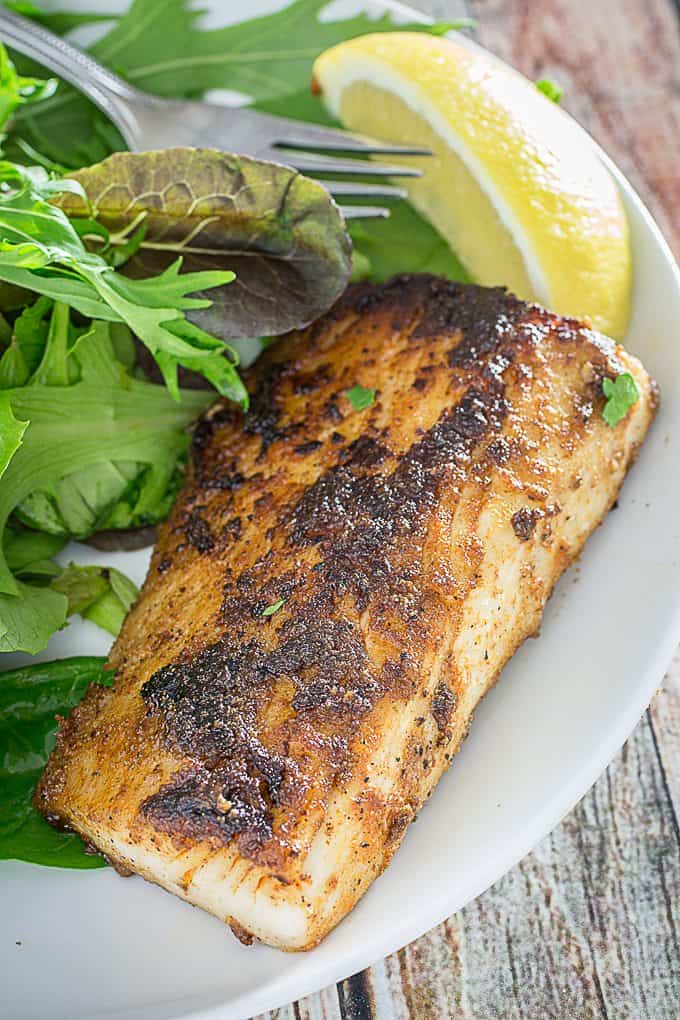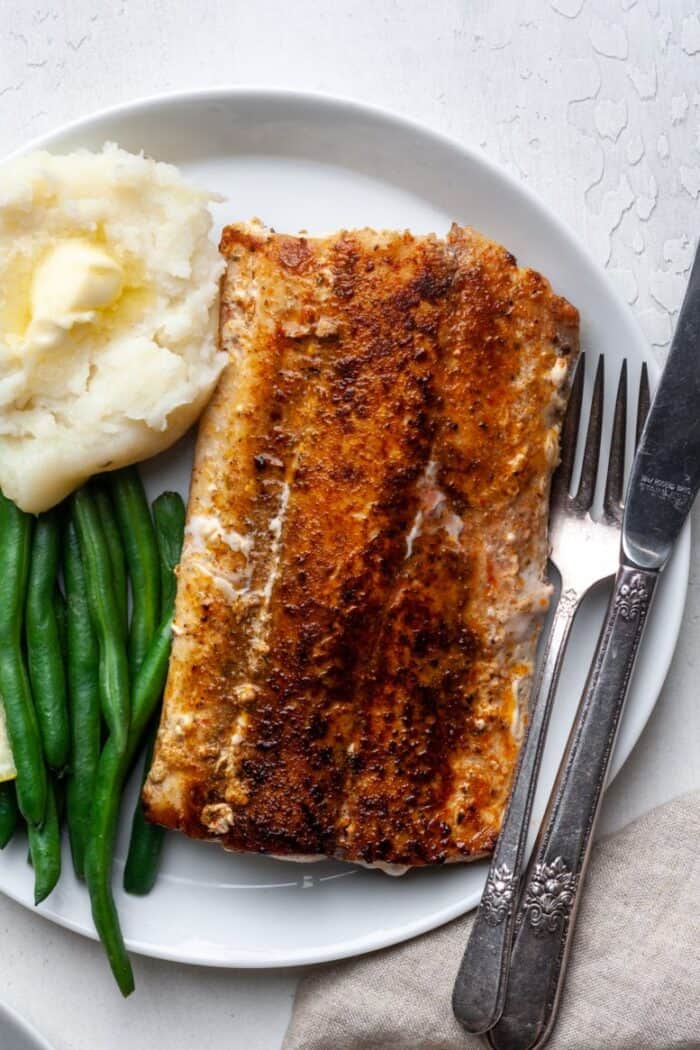Blackened Mahi Mahi: A Culinary Journey from Cajun Country to Your Table

Blackened mahi mahi. The very name conjures images of vibrant spices, sizzling heat, and a flaky, flavorful fish that dances on the palate. This iconic dish, a cornerstone of Cajun and Creole cuisine, transcends its regional origins to become a globally celebrated culinary masterpiece. More than just a cooking technique, blackening is a story of cultural heritage, culinary innovation, and the exquisite potential of a simple, yet remarkably versatile, fish.
Mahi mahi, also known as dorado or dolphin fish (though unrelated to the marine mammal), provides the perfect canvas for this bold technique. Its firm, white flesh holds up beautifully to the intense heat of the blackening spice blend, resulting in a beautifully seared exterior that gives way to a tender, juicy interior. The delicate sweetness of the mahi mahi complements the robust flavors of the spice blend, creating a harmonious balance that’s both exciting and satisfying.
But what exactly is blackening? It’s more than just throwing a bunch of spices on a fish. It’s a precise method that involves a carefully crafted blend of spices, generously applied to the fish, then seared intensely in a very hot pan or on a grill. This high-heat cooking process creates a distinctive, flavorful crust, while leaving the inside of the fish moist and tender. The "blackened" appearance comes from the Maillard reaction, a chemical process that occurs when amino acids and sugars react at high temperatures, producing a complex array of flavors and the characteristic dark brown or black crust.
The history of blackened fish, particularly blackened redfish, is deeply rooted in the rich culinary tradition of Louisiana’s Cajun and Creole cultures. While the exact origins are debated, the technique likely evolved from the resourceful practices of early settlers who sought to preserve and enhance the flavor of their catches. The abundance of spices available in the region, coupled with the need for efficient cooking methods, led to the development of this unique style of cooking. Some attribute the popularization of blackened redfish to Paul Prudhomme, a renowned New Orleans chef who helped bring this dish to national prominence in the 1980s. However, the technique was undoubtedly practiced long before his rise to fame, passed down through generations of cooks who perfected their own unique spice blends.
The beauty of blackened mahi mahi lies in its adaptability. While the classic blackening spice blend typically includes paprika, cayenne pepper, black pepper, garlic powder, onion powder, oregano, thyme, and salt, the possibilities for customization are endless. Experimenting with different spice combinations allows for a wide range of flavor profiles, catering to individual preferences and culinary creativity. Adding a touch of cumin, chili powder, or even smoked paprika can introduce subtle nuances and depth to the flavor. The inclusion of herbs like cilantro or parsley can add a fresh, herbaceous note, while a dash of brown sugar or molasses can provide a touch of sweetness to balance the spice.
Creating the Perfect Blackened Mahi Mahi:
The success of blackened mahi mahi hinges on several key factors:
-
The Spice Blend: Start with a high-quality blend of spices. Freshly ground spices will always offer superior flavor compared to pre-ground blends. Experiment with different ratios of spices to achieve your desired level of heat and complexity. A good starting point is a blend that balances the heat of cayenne pepper with the earthy notes of paprika and the aromatic herbs.

-
The Fish: Choose fresh, high-quality mahi mahi fillets. Look for fillets that are firm, moist, and have a bright, pearly white color. Avoid fillets that are mushy, discolored, or have a strong fishy odor. Properly prepping the fish is also crucial. Pat the fillets dry with paper towels before applying the spice blend to ensure even browning and prevent steaming.

The Heat: High heat is essential for achieving that characteristic blackened crust. A cast-iron skillet is ideal for blackening, as it retains heat exceptionally well. Ensure the pan is adequately heated before adding the fish; a properly heated pan will sizzle immediately upon contact.
-
The Technique: Don’t overcrowd the pan. Blackening requires intense heat, and overcrowding will lower the temperature and lead to steaming instead of searing. Work in batches to ensure each fillet receives sufficient heat. Avoid moving the fish too frequently during cooking; allow it to develop a good crust before flipping.
-
The Rest: Allow the blackened mahi mahi to rest for a few minutes after cooking. This allows the juices to redistribute, resulting in a more tender and flavorful final product.

Beyond the Basics: Serving Suggestions and Variations:
Blackened mahi mahi is a remarkably versatile dish that lends itself to a wide range of serving suggestions. Its bold flavors pair beautifully with a variety of accompaniments, from classic Cajun sides to fresh, vibrant salads.
-
Classic Cajun Sides: Serve blackened mahi mahi with traditional Cajun sides like dirty rice, Cajun-style cornbread, or creamy coleslaw. These sides complement the spice of the fish while adding textural contrast.
-
Fresh and Zesty Salads: A bright, citrusy salad can cut through the richness of the blackened mahi mahi. Consider a salad with avocado, mango, or pineapple, dressed with a lime vinaigrette.
-
Tropical Influences: The mahi mahi’s inherent sweetness makes it a perfect match for tropical flavors. Pair it with coconut rice, grilled pineapple, or a mango salsa for a taste of the islands.
-
Mediterranean Flair: Blackened mahi mahi can also be incorporated into Mediterranean-inspired dishes. Serve it with grilled vegetables, a lemon-herb sauce, or a side of couscous.
-
Elevated Presentations: For a more sophisticated presentation, consider serving blackened mahi mahi over a bed of creamy polenta or risotto. A simple pan sauce, made with the pan drippings and a splash of white wine or lemon juice, can add an extra layer of flavor.
Recipe for Blackened Mahi Mahi:
Ingredients:
- 4 (6-ounce) mahi mahi fillets, patted dry
- 2 tablespoons paprika
- 1 tablespoon cayenne pepper (adjust to your spice preference)
- 1 tablespoon black pepper
- 1 tablespoon garlic powder
- 1 tablespoon onion powder
- 1 teaspoon dried oregano
- 1 teaspoon dried thyme
- 1 teaspoon salt
- 2 tablespoons olive oil
Instructions:
- In a small bowl, combine all spices.
- Generously coat both sides of the mahi mahi fillets with the spice mixture, ensuring complete coverage.
- Heat olive oil in a large cast-iron skillet over high heat until shimmering.
- Carefully place the mahi mahi fillets in the hot skillet, ensuring not to overcrowd the pan.
- Cook for 3-4 minutes per side, or until the fish is cooked through and the crust is blackened.
- Remove from heat and let rest for 2-3 minutes before serving.
Blackened mahi mahi is more than just a delicious meal; it’s a culinary experience that connects us to a rich cultural heritage and celebrates the vibrant flavors of the Cajun and Creole traditions. It’s a testament to the power of simple ingredients, expertly combined and cooked with passion, to create a dish that is both unforgettable and endlessly adaptable. So, gather your spices, heat your pan, and embark on a culinary journey to the heart of Louisiana – one blackened mahi mahi fillet at a time.

Video tentang Blackened Mahi Mahi: A Culinary Journey from Cajun Country to Your Table
Penutup
Therefore, we hope this article has provided valuable insights on Blackened Mahi Mahi: A Culinary Journey from Cajun Country to Your Table. We hope you found this article informative and helpful. See you in our next article!

